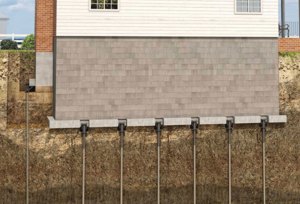A slab foundation is an excellent solution for homes requiring greater accessibility, eliminating the need for crawl spaces or basements and significantly reducing home construction costs.
Builders can quickly erect homes on slab foundations as there’s no waiting time required for concrete foundations to set. But slabs do present certain drawbacks.
No Crawl Space or Basement
Slab foundations don’t feature the open space present in crawl spaces, reducing mold growth and pest activity in your house and the likelihood of floor joist rot and subfloor damage. Know more about Underpinning Melbourne.
A slab foundation is typically constructed of concrete, making it impervious to moisture. You can install a vapor barrier under the slab during construction in order to further minimize mold growth or wood rot issues.
Houses constructed on slab foundations tend to be lower to the ground and require no stairs for accessing them, which makes life easier for people with mobility issues or eldercare needs. Unfortunately, their lack of crawl space makes accessing plumbing and electrical infrastructure repairs more challenging.
No Moisture
A slab foundation removes airspace that could collect moisture, thus reducing mold growth and structural problems that could prove costly and unhealthy for residents of a house.
However, in areas with waterlogged or flooding-prone soils, moisture may still seep into a concrete slab foundation, leading to damage and even rot in wood floor joists. Builders can add a vapor barrier in order to stop this moisture absorption by the concrete itself.
A slab foundation does not leave enough space for heating, ventilation and air conditioning (HVAC) systems and ductwork – increasing construction costs significantly. Furthermore, leaky pipes in such an installation can be hard to detect without opening up the slab foundation; which would be both expensive and time consuming to remedy.
No Insects
Concrete slab foundations present less risk of infestation by termites or other insects due to the limited access they allow, unlike crawl spaces and basements which offer easier entryway for these insects.
However, even a slab foundation cannot guarantee complete protection from bugs; poor drainage may still lead to moisture build-up that creates mold and mildew growth.
Because gas and water lines are embedded within your foundation, any time they need replacing or repairing, requiring you to break into your home is required for replacement or repair – increasing costs while prolonging project timelines.
Slab foundations can crack under cold climate conditions, leading to issues with weight-bearing capacity of the home. To address this problem, t-shaped and frost protected slab foundations are available as a protection measure.
Less Downtime
A slab foundation can be created quickly and with little downtime, as well as require less maintenance than its crawl space or basement counterparts, making it an affordable solution for builders and homeowners alike.
Monolithic slab foundations can be tricky to work with for plumbing repairs and upgrades. When your pipes need servicing, you will likely require breaking through to access them from within the concrete foundation itself.
Colder climates pose additional issues with frost-protected slabs and T-shaped foundations minimizing this concern, while poor insulation could result in higher heating and cooling bills, especially if large trees near your foundation could have roots which threaten its integrity over time. Furthermore, slab-on-grade construction should be avoided by homes where large trees exist near their foundation as this could compromise it over time.
Lower Utility Bills
Opting for a slab foundation has numerous advantages over alternative construction methods, including cost savings as builders don’t need to budget for the creation of crawl spaces and basements – which saves both time and materials during construction.
Homes built on concrete slabs may also be constructed closer to ground level, which reduces the number of steps needed to enter their home and can be especially helpful for older homeowners and those with mobility challenges.
One drawback of a concrete slab foundation is the presence of plumbing pipes embedded within it, which may present issues when worn out or needing repair. To access them, a plumber would need to break through the foundation using jackhammers – increasing costs and length of time necessary for any necessary repairs to be carried out.
